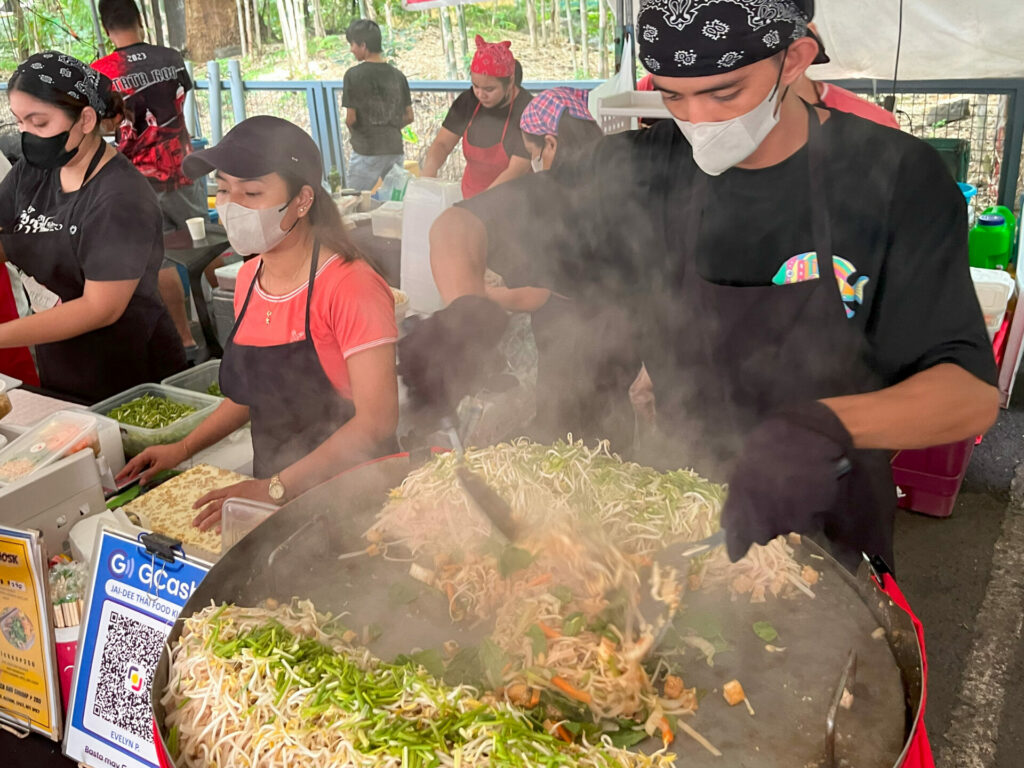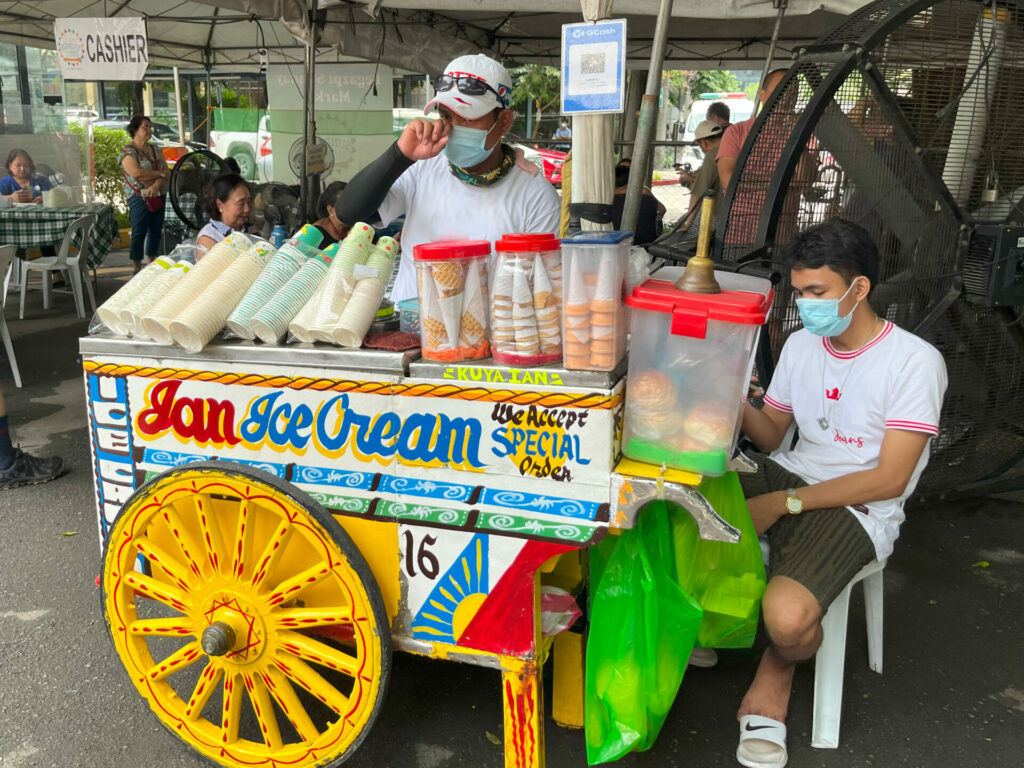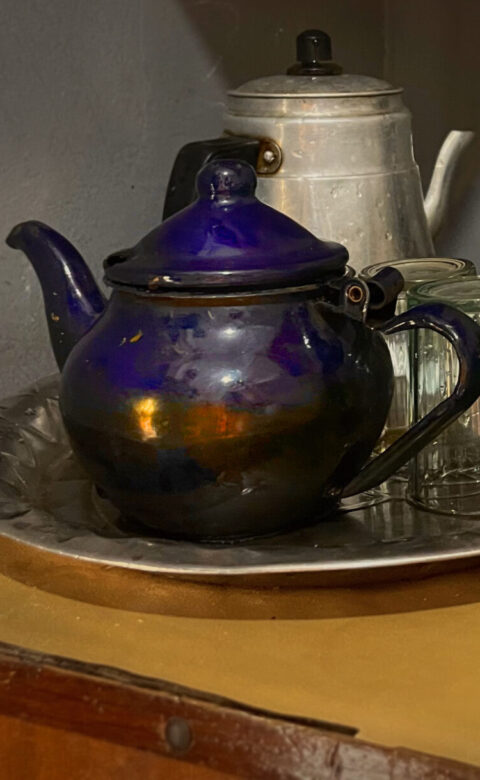I come to Legazpi market every Sunday. I’m 9,000 km away from my family and friends, I work remotely and alone. Hence, this market in Manila gives me a sense of familiarity and belonging, but also the novelty I need. I make friends among the vendors but also talk to strangers and taste new dishes.
In a small, temporarily emptied parking lot in the Makati district — the country’s financial, commercial, and economic centre — potential clients are abuzz, browsing amongst the vendors starting their Sunday morning early. Tourists carrying suitcases, people with dogs on leashes or strollers, mothers holding children, men in skintight Lycra suits with racing bikes, foreigners filming with GoPros or phones, groups of friends. They do some window shopping; nobody is in a rush.
Most of the time, my route in the market is the same. After I finish my workout in the park, with the exercise mat under my arm, I pass by the pavilion where the mass is held. After 11 am, almost every attendee at the service will have migrated to the market.
My first stop is at the booth with Thai food, where I place my order: Pad Thai with whatever they are cooking on the hob — shrimp, tofu, or chicken. One of the ladies already knows my taste, so she makes a note on a slip of paper: “Foreigner, no spicy”. The smells of coriander, tamarind, and lemon juice make my mouth water.

My next destination is Jean’s, a Frenchman who has been selling food in the Legazpi market for six years. 18 years ago, his Filipina wife, a chef, started to sell in another market, on Saturdays, focussing on only two French dishes: beef bourguignon and beef lasagna. Meanwhile, they opened a restaurant and delivered food to the US Embassy for some years. Now, they need two big tables to display their offering.
When my husband and I first arrived in the Philippines in 2018, this couple’s cuisine was the closest to Romanian food that we could find in the market. Because I was homesick, I then adopted the habit of coming here every Sunday. I felt at home while chewing the juicy lamb shank with lemon sauce, biting into the tasty chicken skewers, or devouring the flavourful moussaka with eggplant. On the flip side, when we were back in Romania during the pandemic, we also missed Jean’s food when we were missing the Philippines.
I always take the food home to share it with my husband at lunch. So, with the boxes of French dishes in my hand, I stop at the Filipino booth. They sell chicken, pork, and intestines on sticks, along with fish and squid. Everything is cooked on two large grills. Even if you’re not hungry or you don’t feel like eating meat, the smoky fragrance that fills the air will make you at least stop and look. My favourites are the sweet, boneless milkfish and the mouth-watering squid stuffed with succulent tomatoes and crunchy onions.

I think about going home, but I catch the sweet and tropical aroma of the jackfruit, a mix between ripe pineapple and mango. A girl is peeling a jackfruit somewhere nearby, and I can’t resist the smell. Out of a kilo of the whole, spiny fruit, the sweet, edible part is only 250 grams. I buy one box, and, on my way out, with my full and heavy bag on one shoulder and my mat under the other arm, I know I will struggle if I buy anything else. But I can’t say no to a buko — young coconut with its refreshing juice. A guy with half the thumbnail missing on his left hand is shaping and opening the round fruit with a machete for me, and now I have to waddle like a penguin for five minutes home, carefully carrying the tasty food.
Though I do have a routine, occasionally I spend time discovering new dishes and exploring the market. The selection is generous, displayed under tarpaulins, protected from the heat of the tropical sun: Filipino, Indian, Malaysian, and Indonesian food, fresh fish, fruits and vegetables, bouquets of flowers and potted plants, boiled peanuts, local coffee and honey, bread and naan, all kinds of rice, and even a zero-waste booth.
Last week, I discovered a new dish I now love: köfte, a Turkish food consisting of ground meat served in pita bread with tomatoes and salad. Walking through the lively market, I heard a welcoming voice calling me: “Come here, my friend!”. The vendors who shout joyfully to their prospective buyers always have the most clients, and this Turkish gentleman is definitely a prime example of the technique. His booth was buzzing with activity, and I couldn’t resist popping over to see what he had to offer. I was about to find out as he handed me a sample: the most delicious seasoned minced meat I had tasted in some time. I asked him not to use onions in my köfte, and he yielded, saying to his staff: “All the onions that we have, so nobody will kiss this girl!”

Once in a while, I buy dirty ice cream, my favourite treat from the Philippines. Also known as sorbetes, it’s not actually dirty, but they have referred to it this way for generations because it is traditionally sold by street vendors and potentially exposed to all sorts of street pollution as a result.
Stored in metal canisters in colourful pushcarts, the milky, delicately sweet ice cream is made of churned cream and chunks of mango, jackfruit, avocado, or cheese. “We call this dirty ice cream,” an old, smiling lady with green-brown eyes told me last week as I waited in line, close to a giant fan. “But we still eat it, since childhood.”
Familiarity is a powerful feeling, especially when it comes to food, and French and Turkish cuisines have become my personal sources of comfort in the Philippines. It’s incredible how the flavours and textures of certain foods can evoke a sense of nostalgia and warmth, no matter where we find ourselves in the world.









